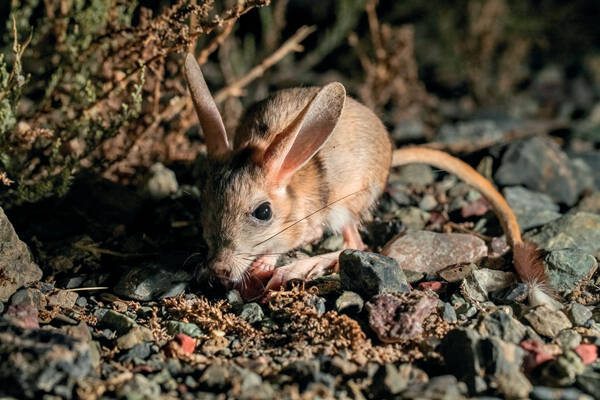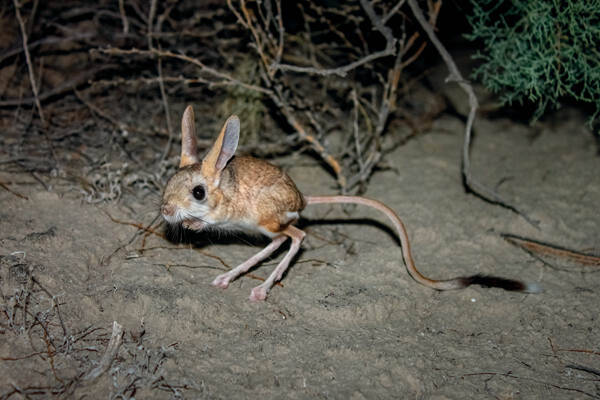Allactaga sibirica
IUCN
LCBasic Information
Scientific classification
- name:Allactaga sibirica
- Scientific Name:Allactaga sibirica,Mongolian five-toed Jerboa,Five-toed jumping rabbit, jumping rabbit, jumping mouse
- Outline:Rodents
- Family:Rodentia Jerboa F.Jerboa
Vital signs
- length:130-170mm
- Weight:
- lifetime:
Feature
It is the largest species in the jerboa family, with a round head, big eyes, and big ears that can be folded forward to reach the tip of the nose. Its back is gray and its abdomen is pure white.
Distribution and Habitat
Distributed in northern China, including the northern part of the Tarim Basin in Xinjiang to northern Xinjiang, eastward including the northern grasslands and desert areas of Inner Mongolia and Gansu, Qinghai, Ningxia, Shanxi, and Hebei, as well as the grassland areas in western Heilongjiang and Jilin. Distributed abroad in Russia and Mongolia.
Five-toed jerboas mainly live in semi-desert grasslands and hillside grasslands, especially preferring dry grassland environments as habitats, and can occasionally be seen in desert areas.
Appearance
Adults are larger. Body length is usually over 130mm, but rarely exceeds 170mm. Hind feet length 65-75mm. Ear length averages 47mm, and tail length averages slightly over 200mm. The back of the body is gray-brown, sometimes with a distinct gray-black tone, and the belly is pure white. The end of the tail is in the shape of a brush. The section of the "brush" close to the body is white or off-white, the middle is black, the black part is longer, and the tail end is white but very short. The hind feet are 3-4 times as long as the front feet and have 5 toes, suitable for jumping. The sides of the middle 3 toes of the hind feet are covered with longer brown hairs. Compared with the small five-toed jerboa, the five-toed jerboa is larger in size, slightly darker in color, and has a longer black part at the end of its tail.
Details
Five-toed jerboas belong to the Allactaginae subfamily. The species-level classification of five-toed jerboas is stable, and the subspecies differentiation is complex. There are more than 10 species, including 5 in my country, including the current Mongolian five-toed jerboas. But whether they are all valid subspecies needs further study.

Five-toed jerboas have strong adaptability and a wide range of activities. They do not live in groups. Five-toed jerboas are nocturnal animals. They are active frequently at dusk and occasionally come out of their caves during the day. The distance of their activities is usually 1-2 km. They dig many temporary caves in the places they pass through, which are used for hiding in danger or temporarily staying overnight. The temporary caves are simple, with only one entrance, which is in the shape of an arch bridge with a round top and a low bottom. The tunnels of temporary caves are shallow and mostly parallel to the ground. There is no living nest. The living caves are often built in relatively solid soil. The caves are relatively complex. The entrances are divided into three types: excavation entrance, entrance and exit entrances, and spare entrances. The excavation entrance is the exit from the earth when the cave is built. There is often a pile of floating soil outside the entrance. The tunnels are inclined downward and vary in length. The excavation caves and their tunnels are blocked after the caves are built. There is no floating soil around the entrance and exit caves, which are very hidden. The tunnels are small and gentle. The soil tunnels are shorter, and the tunnels on the sand dunes are longer. The end of the tunnel is expanded into a nesting chamber. During the breeding period, soft grass leaves and the fluff and wool of the jerboas themselves are padded. The backup hole is located close to the nest, straight to the ground but not dug through, and only 1-2cm away from the ground. In critical moments, they often rush out from here. Five-toed jerboas only use their two hind legs to jump and balance their bodies with their tails. They are extremely agile and move fast.
Five-toed jerboas have the habit of hibernation. The hibernation cave is similar to the habitat cave, but the tunnel extends downward to the permafrost layer. Every year, they enter hibernation from early September until they wake up and go out of the cave to look for food in March or April of the following year.

Five-toed jerboas mainly feed on plants. In early spring, they mainly feed on seeds, grass roots, and some beetles. In summer, they mainly feed on wild green plants, and sometimes steal seedlings of some crops, fruits and vegetables from cultivated land, or sneak into farmers' pig pens to steal food.
Five-toed jerboas have many natural enemies. For example, owls among birds, mustelids, sand foxes, and caracals among mammals.
Five-toed jerboas reproduce once a year. They come out of hibernation from mid-March to early April. April and May are the peak mating seasons, when males move around a large area and frequently, and there are more males than females. They give birth in June, with 2-4 babies per litter, and up to 7 babies. In July, most of the young mice come out of their holes, and most of them are young male mice, so males are dominant at this time. After August, the sex ratio is basically balanced until hibernation, so their sex ratio has seasonal changes.








